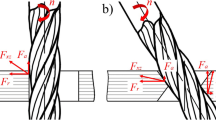Abstract
This study proposes a methodology for helical mill-grinding of tiny internal threads made of hard brittle materials such as SiCp/Al composites. The methodology uses the helical mill-grinding method incorporating with a diamond form-grinding wheel. A mathematical model is established to predict thread form errors and provide a rational range of wheel parameters, such as variation of tool profile angle Δα and ratio of the wheel diameter to the thread major diameter η. Based on the methodology, a grinding wheel is developed for processing the M2 internal threads in a validation experiment. The study demonstrates that an M2 internal thread made of the SiCp/Al composite of 45% SiC volume fraction is successfully machined in 5 min with pitch error <0.08% and angle error <0.3%. The thread profile on the pitch diameter is within the axial equivalent tolerance zone (0–0.016 mm), which indicates that the thread precision reaches the H4 level.
Similar content being viewed by others
References
Saito Y, Takiguchi S, Yamaguchi T, Shibata K, Kubo T, Watanabe W, Oyama S, Hokkirigawa K (2016) Effect of friction at chip-tool interface on chip geometry and chip snarling in tapping process. Int J Machine Tools Manuf 107:60–65
Cao TY, Sutherland JW (2002) Investigation of thread tapping load characteristics through mechanistics modeling and experimentation. Int J Machine Tools Manuf 42(14):1527–1538
Pawar S, Joshi SS (2016) Experimental analysis of axial and torsional vibrations assisted tapping of titanium alloy. J Manuf Process 22:7–20
Domblesky JP, Feng F (2002) A parametric study of process parameters in external thread rolling. J Mater Process Technol 121(2):341–349
Maciel DT, Filho SLMR, Lauro CH, Brandao LC (2015) Characteristics of machined and formed external threads in titanium alloy. Int J Adv Manuf Technol 79(5):779–792
Ivanov V, Kirov V (1997) Rolling of internal threads: part 1. J Mater Process Technol 72:214–220
Pater Z, Gontarz A, Weroñski W (2004) New method of thread rolling. J Mater Process Technol 153(22):722–728
Khoshdarregi MR, Altintas Y (2015) Generalized modeling of chip geometry and cutting forces in multi-point thread turning. Int J Machine Tools Manuf 98:21–32
Akyildiz HK (2013) Evaluating of cutting forces in thread machining. Int J Adv Manuf Technol 68(5–8):1601–1612
Dudás I, Bodzás S, Dudás IS, Mandy Z (2015) Development of spiroid worm gear drive having arched profile in axial section and a new technology of spiroid worm manufacturing with lathe center displacement. Int J Adv Manuf Technol 79(9–12):1881–1892
Song SQ, Zuo DW (2014) Modelling and simulation of whirling process based on equivalent cutting volume. Simul Model Pract Theory 42(3):98–106
Mohan LV, Shunmugam MS (2007) Simulation of whirling process and tool profiling for machining of worms. J Mater Process Technol 185(1):191–197
Fromentin G, Poulachon G (2010) Modeling of interferences during thread milling operation. Int J Adv Manuf Technol 49(1):41–51
Fromentin G, Poulachon G (2010) Geometrical analysis of thread milling—part 1: evaluation of tool angles. Int J Adv Manuf Technol 49(1):73–80
Fromentin G, Poulachon G (2010) Geometrical analysis of thread milling—part 2: calculation of uncut chip thickness. Int J Adv Manuf Technol 49(1):81–87
Araujo AC, Silveira JL, Jun MBG, Kapoor SG, DeVor R (2006) A model for thread milling cutting forces. Int J Machine Tools Manuf 46(15):2057–2065
Araujo AC, Fromentin G, Poulachon G (2013) Analytical and experimental investigations on thread milling forces in titanium alloy. Int J Machine Tools Manuf 67(2):28–34
Wan M, Altintas Y (2014) Mechanics and dynamics of thread milling process. Int J Machine Tools Manuf 87:16–26
Lee SW, Kasten A, Nestler A (2013) Analytic mechanistic cutting force model for thread milling operations. Procedia Cirp 8(8):546–551
Skoczylas L, Pawlus P (2016) Geometry and machining of concave profiles of the ZK-type worm thread. Mech Mach Theory 95:35–41
Chiang CJ, Fong ZH, Tseng JT (2009) Computerized simulation of thread form grinding process. Mech Mach Theory 44(4):685–696
Chiang CJ, Fong ZH (2009) Undercutting and interference for thread form grinding with a tilt angle. Mech Mach Theory 44(11):2066–2078
Wu YR, Hsu WH (2014) A general mathematical model for continuous generating machining of screw rotors with worm-shaped tools. Appl Math Model 38(1):28–37
Lee SW, Nestler A (2012) Simulation-aided design of thread milling cutter. Procedia CIRP 1(1):120–125
Leon FM, Pai NG, Hess DP (2001) The effect of thread dimensional conformance on yield and tensile strength. Eng Fail Anal 8(1):49–56
Kadivar MA, Akbari J, Yousefi R, Rahi A, Nick MG (2014) Investigating the effects of vibration method on ultrasonic-assisted drilling of Al/SiCp metal matrix composites. Robot Comput-Int Manuf 30(3):344–350
Sahoo AK, Pradhan S (2013) Modeling and optimization of Al/SiCp MMC machining using Taguchi approach. Measurement 46(9):3064–3072
Li AH, Zhao J, Wang ZM, Zheng W (2011) Elastic properties of WC-Co cemented carbides. Cemented Carbide 28(3):194–198 (in Chinese)
Nie HB (2010) Determination of elastic modulus of cemented carbides by three-point bend tests. Mater Sci Eng Powder Metall 15(6):606–610 (in Chinese)
Author information
Authors and Affiliations
Corresponding author
Rights and permissions
About this article
Cite this article
Gao, H., Lu, S., Yang, A. et al. A methodology for helical mill-grinding of tiny internal threads made of hard brittle materials. Int J Adv Manuf Technol 91, 25–37 (2017). https://doi.org/10.1007/s00170-016-9727-5
Received:
Accepted:
Published:
Issue Date:
DOI: https://doi.org/10.1007/s00170-016-9727-5



